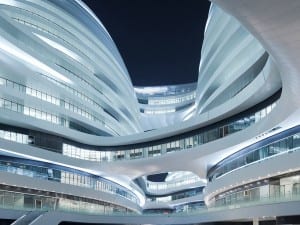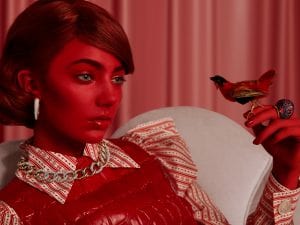Having graduated from Norwich School of Art in 2010, Lucy Fiona Morrison has pursued a passion for painting, working as a professional artist and painter in Yorkshire. With the West Yorkshire landscape standing as an inherent influence in her oil works, Aesthetica talk to Morrison about traditional methods in the face of technological development and the alluring romanticism of nature.
A: Why is it that you choose oil paintings are your medium? In the digital age with so many advancements and different media to sample, what is it about this traditional method that speaks to you?
LM: I suppose when I was studying I was most attracted to works that played with light but I admired the level of skill required to create an oil painting which I wanted to emulate.
Oils have stood the test of time. Technology is advancing so rapidly that works could be quickly outdated, whereas oil painting has roots stretching back in Europe to the fifteenth century, but still has more to give through experimentation. I get great satisfaction from working with something that can be deconstructed and adapted at my will, for example, changing the viscosity of the medium with linseed and poppy seed oil to create different textures and effects. I invest myself in the work with creating my own pigment and colour making, modifying the particles of pigment. I am continually experimenting with raw pigments and their resulting effects.
Digital art is impactful and can be greatly manipulated however I prefer the effects that are produced with traditional mediums, every mark made on the painting is unique and cannot be recreated; to be able to feel every brush stroke, to be hands on, is important to me.
A:With a strict adherence to light and tone, your works are constantly in a state of play with the world around us. Why is it, do you think, that these everyday phenomena of dramatic skies and earth colours speak to us on such a primal level?
LM: Landscape is a constant, although seasons and colours change it is an expectation that these elements of mother nature will always be present and a belief in this gives a sense of safety and comfort in the familiar. When we are out the in the landscape and there is nothing for miles except an ever changing sky and the endless horizon it gives us the realisation that we are only a small part of the puzzle. It is that innate beauty that is made so naturally by the environment that I am recording. The idea that a stormy sky can produce a variety of, not only colours, but texture, dimension and energy. Every cloud is unique in its formation.
A: You mention that your works have certain thematic recurrences, for example, trying to capture nature in its fleeting moments of beauty. How far do you think that artists are trying to create a tangible record of a world completely in flux?
LM: I think it’s a very valid area to investigate as there are more threats towards our way of life, our country, our planet. With a level of unpredictability, I think it is important to capture the here the now. For me, the here and now is insuring the beauty of the landscape is appreciated and not overlooked or undervalued. Showing the fluidity and adaption of the natural world is very important. Environments change, habitats are lost, I believe it’s important to capture those raw and captivating views of the environment whilst they are still available to us and to keep a record of what could potentially be lost in the future.
Artists capture a feeling, a reaction, a personal story. Art is constantly adapting to social change and people’s opinion.
A: How do your works respond to urbanisation?
LM: As the population is expanding it is inevitable that more and more countryside will be turned over to sprawling towns and cities, but our landscapes, in which you can just breath and exist rather than rush through your day, are important for the soul. It would be saddening to think that some of the views I have painted will not be quite so serene or empty for the next generation, so I would like to think that people would see my work and be enthused to go out and explore and make the most of what we have right now.
A: Your upcoming art show is at The Great Yorkshire show this year – as the West Yorkshire landscape has been your greatest influence throughout your career, are you passionate about being featured within your home region?
LM: The Yorkshire landscape has inspired me throughout my career and I am absolutely thrilled to be part of The Great Yorkshire Show Art Show this year. I will be exhibiting alongside a group of the region’s top artists as well as doing a painting demonstration to share my passion for pigments.
It is easy for people to be London-centric but great art is made everywhere and I think it is important to celebrate that in my home county. I am truly thankful for all the support and early buyers of my work from Yorkshire that have led to the success I have now.
A: How do you think that the public respond to artwork created with a recognisable landscape as opposed to somewhere entirely different culturally?
LM: For a UK audience, my images of the countryside give suggestions of something familiar enough to the audience that they can ground themselves in it with their own memories or reminiscence of being somewhere similar; I believe they can own that image easier. With a landscape more exotic the audience are allowed to fantasise, bringing only thoughts of what they believe to be true. They can attribute their feelings, knowledge and experience to recognisable landscapes.
A: You will also be travelling to The Other Art Fair in Bristol – how do you think this will compare to the former summer exhibition? Do you have any other shows/projects planned?
LM: The Other Art Fair in Bristol will be a completely different experience. I am looking forward to exhibiting alongside other contemporary artists and welcoming an audience that is there because they love art. Having never exhibited in the region it is a great opportunity to meet new people, be inspired by new conversations and develop more advocates for my work.
I always have multiple paintings on the go. A few of my upcoming projects include a set of paintings that represent the Cornish seascapes and experimental works creating oil paintings on alternative surfaces. I will be using an open studio event on 6th and 7th August (10am – 4pm, GU12 4DG) as an opportunity to gain feedback on these projects.
The Great Yorkshire Show runs from 12-14 July.
The Other Art Fair runs from 22-24 July.
To see more of Lucy’s works: www.lucyfionamorrison.co.uk
Credits:
1. Lucy Morrison, Calm After The Storm, (2016). Courtesy of the artist.
2. Lucy Morrison, Looking into the Sky, (2016). Courtesy of the artist.
3. Lucy Morrison, Yellow Opening, (2016). Courtesy of the artist.




